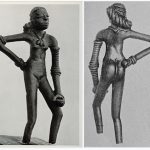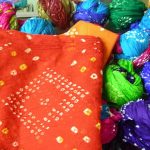Tie-dye is a popular form of textile design that has been around for centuries. It is a dyeing technique in which fabric is tied, twisted, or folded in different ways to create patterns and designs. The process of tie-dyeing involves first soaking the fabric in a dye bath, then using a variety of tying methods to resist the dye and create the desired pattern.
The origins of tie-dye can be traced back to ancient civilizations in Africa, Asia, and South America, where it was used for spiritual and cultural ceremonies, as well as for everyday clothing.
Tie-dye is a traditional dyeing technique in India, where the fabric is tied tightly with string or rubber bands in specific patterns before being dyed. This creates a unique, multicolored effect on the fabric. Tie-dye is widely used in India to create vibrant and colorful clothing, especially in the northern state of Rajasthan where it is known as “bandhani.” or “bandhej”.
Laharia is a traditional form of tie-dye from the state of Rajasthan in India. It is a type of bandhani, which is a common form of tie-dye in India. The technique involves tightly tying small knots on the fabric with a string, which resists the dye and creates intricate patterns. Laharia is typically done on cotton or silk fabric and is characterized by its use of bright and vibrant colors. The resulting patterns are usually geometric or floral, and the fabric is often used to make clothing, such as sarees and dupattas, as well as other decorative items like bed sheets and curtains.
Ikat is a traditional textile dyeing technique that involves tying and dyeing individual threads before they are woven into fabric. The word “ikat” comes from the Indonesian word “mengikat,” which means “to tie.” The technique is used to create intricate patterns and designs on the fabric.
In the ikat process, the threads are first tied in a specific pattern, then dyed. The tied threads resist the dye, creating a pattern on the finished fabric. The process is repeated with different colors to produce the final design. Ikat is widely used in many countries, including India, Indonesia, Central Asia, and South America, to create unique and intricate textiles. The resulting fabrics are often used for clothing, home decor, and other functional items.
Thigma is a traditional tie-dye technique from the Ladakh region in India. Thigma is typically done on woolen shawls, which are commonly worn in the Ladakh region to protect against the cold. The shawls are decorated with intricate designs and bright colors, making them a distinctive part of the local culture and tradition. Thigma is considered an important part of Ladakh’s cultural heritage, and is passed down from generation to generation through families engaged in the textile trade.
The technique is also popular in the southern state of Tamil Nadu, where it is known as “pattadai.”
In India, tie-dye is usually done on cotton fabric using natural dyes derived from plants and minerals.This process is also known as resist dyeing process.
Internationally, Tie-dye is often associated with the hippie movement of the 1960s, where it became a symbol of counterculture and anti-establishment attitudes.
Tie-dyeing is a relatively simple process, and it can be done at home with a few basic supplies, including fabric, dye, rubber bands or string, and a workspace that can be easily cleaned. The first step is to prepare the fabric by soaking it in a solution of water and soda ash to help the dye adhere to the fibers. The fabric is then wrung out and tied or twisted in a variety of ways, depending on the desired pattern. The tied fabric is then placed in the dye bath and left to soak until the desired color is achieved.
One of the great things about tie-dye is that it can be used to create an endless variety of patterns and designs, from simple spirals to intricate geometric shapes. It is also a fun and creative activity that can be enjoyed by people of all ages. Whether you are looking for a fun way to brighten up a plain T-shirt, or you are looking to create a unique piece of wearable art, tie-dye is a great choice.
In recent years, tie-dye has experienced a resurgence in popularity, with many fashion brands incorporating tie-dye designs into their collections. From clothing to home décor and accessories, tie-dye is now being used in a wide range of products, making it a versatile and timeless design trend.
Whether you are a seasoned tie-dye artist or a beginner just starting out, there has never been a better time to get creative with this timeless craft. So grab your fabric, some dye, and a few rubber bands, and start exploring the world of tie-dye!
Image courtesy https://commons.wikimedia.org/wiki/File:Bandhani_%282150279080%29.jpg
under Creative Commons Attribution-Share Alike 2.0 Generic license





